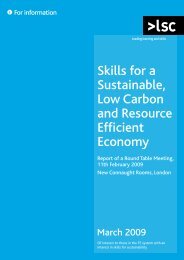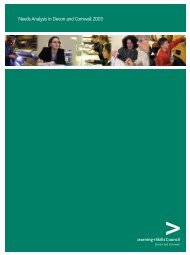Mapping the Big Green Challenge - The Skills & Learning ...
Mapping the Big Green Challenge - The Skills & Learning ...
Mapping the Big Green Challenge - The Skills & Learning ...
You also want an ePaper? Increase the reach of your titles
YUMPU automatically turns print PDFs into web optimized ePapers that Google loves.
140 Chapter 7.12 - Conclusions: A Comparison of <strong>the</strong> Proposal Types7.12 Conclusions: A Comparison of <strong>the</strong> Proposal Types<strong>The</strong> proposal types are based on a shared approach to engaging with a community in relation tocarbon reduction goals. Within this <strong>the</strong>y contain considerable diversity in terms of o<strong>the</strong>r factorsconsidered in this report. Never<strong>the</strong>less some comparative points can provide some broad sense ofhow <strong>the</strong> types related to each o<strong>the</strong>r. <strong>The</strong> detailed analysis that underpins this account is presentedas an Appendix.7.12.1 Types of 3 rd Sector Organisation InvolvedIn terms of <strong>the</strong> type of challenger group making <strong>the</strong> proposal <strong>the</strong>ir level of formality (which at leastfor groups with a bottom-up / independent origin we would expect to provide a rough indication ofage, scale of operation in terms of area, numbers of people engaged, likelihood of seeking externalfunds) links to some of <strong>the</strong> proposal types in expected way. So informal groups (constituted and unconstituted)tend to focus <strong>the</strong>ir activities within clear geographical areas - <strong>the</strong> Zones and LocalProjects proposals. In line with this explanation, where Local Projects were proposed by groupsexternal to that community <strong>the</strong> <strong>Challenge</strong>r making <strong>the</strong> proposal was more likely to be a formal group(charity or not-for-profit company). Where <strong>the</strong> proposal involved engaging with young people(youth schemes) or offering advice (including financial), as would be expected by <strong>the</strong> issues raised by<strong>the</strong>se type of activities, <strong>the</strong> <strong>Challenge</strong>rs making <strong>the</strong> proposals were more likely to have a formal legalstructure. <strong>The</strong> Public Buildings proposals were most likely to be proposed by (non-environmental)Charities – in this case because <strong>the</strong>y were normally <strong>the</strong> owners of <strong>the</strong> building. Not all <strong>the</strong> Enterpriseproposals were from social enterprises however – early stage ones were often from informal groups.<strong>Challenge</strong>rs who came from a clear community of interest (Connections proposals or in a differentsense <strong>the</strong> Public Buildings) were least likely to have an existing environmental focus. Local Projectproposals with <strong>the</strong>ir tighter focus were most likely to be made by groups with an environmentalfocus. In some cases <strong>the</strong>re was a link with formality: for example Zone proposals were made bothby informal environmentally focussed groups and by more formal groups (e.g. Development Trustsand Parish Councils) with existing interests in community services or economic regeneration.7.12.2 Carbon Reduction and Innovation GoalsApart from <strong>the</strong> obvious connections between non-residential energy use and <strong>the</strong> Public Buildingsand (<strong>the</strong> often school-based) Youth Scheme proposals, and a focus on residential energy in <strong>the</strong> localZones proposals, <strong>the</strong> spread of carbon reduction measures is fairly evenly distributed across <strong>the</strong>proposal types. Nei<strong>the</strong>r was <strong>the</strong> number of different measures a good differentiating factor, partlybecause some categories (particularly ‘awareness raising’ and some lifestyle ones) are very broadand because <strong>the</strong> inclusion of a measure does not give an indication of <strong>the</strong> relative emphasis itreceived in <strong>the</strong> proposal. All proposal types o<strong>the</strong>r than inventions have a strong focus on practicegoals which require behaviour change (strongest for Zones, Services and Youth Schemes) even whenthis would not be obvious from <strong>the</strong>ir name e.g. Public Buildings.Systemic proposals were most common in <strong>the</strong> Services and Zone proposal types but <strong>the</strong>y variedsignificantly in <strong>the</strong> number of measures targeted with <strong>the</strong> services concentrating on broadawareness raising whereas <strong>the</strong> Zone proposals intended to address many more specific measures.<strong>The</strong> more ‘business-focussed’ proposal types Inventions and Enterprises were, by contrast, highlysingular with a focus on a product or core business activity.Appleby Ltd July 2009











